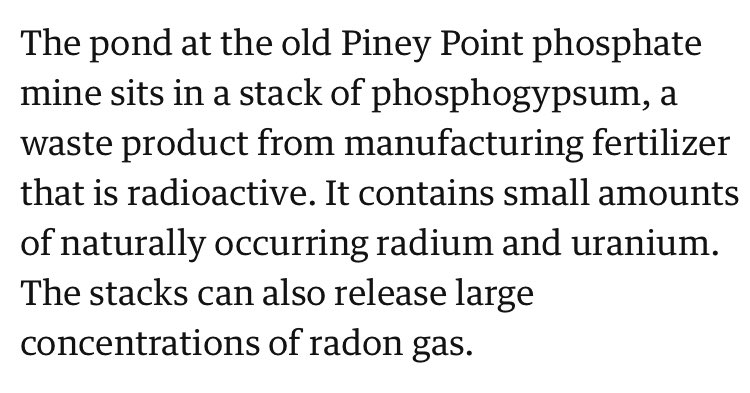
Did you see the alarming message? RADIOACTIVE FLOOD! (@guardian)
A thread about naturally occurring radioactivite material (NORM). 👇🏻
theguardian.com/us-news/2021/a…
A thread about naturally occurring radioactivite material (NORM). 👇🏻
theguardian.com/us-news/2021/a…
1. I saw some people on Twitter yesterday who were expressing worries, e.g.: @lydiavanh, @nordicdoor_4, @markmobility, @xlpiano, @ArjenPolku, @brkw12.
I’ll get back to those worries, but first I have to explain some basics about radioactivity: 👇🏻
I’ll get back to those worries, but first I have to explain some basics about radioactivity: 👇🏻
2. No worries!
All stuff on Earth is radioactive. All? Yes, literally.
The water, soil and air, all radioactive!
All the world contains naturally occurring radioactive substances: uranium, thorium, radon, radium, potassium-40, carbon-14, beryllium-7, tritium, ...
All stuff on Earth is radioactive. All? Yes, literally.
The water, soil and air, all radioactive!
All the world contains naturally occurring radioactive substances: uranium, thorium, radon, radium, potassium-40, carbon-14, beryllium-7, tritium, ...
3. This results in a measurable dose rate all around the world.
In my country, the Netherlands, this map shows the differences in dose rate. Sandy soils have lower (yellow), and clay (red) has higher dose rates. Rock soil has far higher natural dose rates. 😊
In my country, the Netherlands, this map shows the differences in dose rate. Sandy soils have lower (yellow), and clay (red) has higher dose rates. Rock soil has far higher natural dose rates. 😊

4. So if water, air and soil are radioactive, so are all things breathing and drinking and all things having roots: humans, animals, vegetables, etc.
Yes people, you are radioactive, all of you! 😊
Yes people, you are radioactive, all of you! 😊

5. So let’s look at your healthy drinks: water is least radioactive, a banana smoothie much more so, but your veggie shakes really top the bill, radioactivity-wise.
Don’t get me wrong: they’re absolutely healthy. And radioactive.
Don’t get me wrong: they’re absolutely healthy. And radioactive.

6. So if you down a few veggie shakes, and go to the toilet afterwards?
Are you then releasing a RADIOACTIVE FLOOD into the sewage system? Absolutely! 😂
Is what you’re doing a health, or an environmental hazard? I think not.
Or is it? 🤔😷
Are you then releasing a RADIOACTIVE FLOOD into the sewage system? Absolutely! 😂
Is what you’re doing a health, or an environmental hazard? I think not.
Or is it? 🤔😷
7. OK. So now we know that a RADIOACTIVE FLOOD need not be scary. We do it ourselves, day after day.
Bus isn’t it illegal, causing a RADIOACTIVE FLOOD ?
That depends on how much activity you’re releasing, and how concentrated it is.
Bus isn’t it illegal, causing a RADIOACTIVE FLOOD ?
That depends on how much activity you’re releasing, and how concentrated it is.
8. Very low levels of radioactive substances are EXEMPT, i.e. legally not considered to be radioactive.
ec.europa.eu/energy/sites/e…
ec.europa.eu/energy/sites/e…
9. Now let’s go back to the @guardian article. Let’s look at some key statements in there.
theguardian.com/us-news/2021/a…
theguardian.com/us-news/2021/a…
10. So it’s a phosphate mine. A natural phenomenon.
These substances were already there, for zillions of years. It’s called NORM: naturally occurring radioactive material.
Polluted with NORM? Depends on the concentrations. Might even be exempt (legally non-radioactive).
These substances were already there, for zillions of years. It’s called NORM: naturally occurring radioactive material.
Polluted with NORM? Depends on the concentrations. Might even be exempt (legally non-radioactive).

11. But without information about concentrations, we don’t know if there’s a legal problem other radioactivity or not.
Chemically speaking, it could be an environmental hazard: no one would like to have their land flooded with phosphorus and nitrogen compounds.
Chemically speaking, it could be an environmental hazard: no one would like to have their land flooded with phosphorus and nitrogen compounds.

12. But it is *not* necessarily a hazard because of natural radioactivity!
Remember that the land surrounding the mine already is radioactive, containing uranium, thorium, radium, radon etc.
Remember that the land surrounding the mine already is radioactive, containing uranium, thorium, radium, radon etc.

13. It could be that (because of mining and chemical processes), the concentration of these substances is enhanced above the exemption levels.
Then it becomes a legal issue: there probably is no permit to to flood the county with those substances.
Then it becomes a legal issue: there probably is no permit to to flood the county with those substances.
14. Conclusion: it could be an environmental disaster in the making. Probably because of the chemicals.
Is radioactivity the main issue? Certainly not. It just has the “scare factor”.
And articles like this one in the @guardian keep installing fear of radioactivity in people.
Is radioactivity the main issue? Certainly not. It just has the “scare factor”.
And articles like this one in the @guardian keep installing fear of radioactivity in people.
15. It could be a costly thing though. In the Netherlands, the ThermPhos phosphorus factory went bankrupt in 2012. Because waste was contaminated above the exemption level with NORM, cleaning costs were about 100 million euro.
amp.nos.nl/artikel/233082…
amp.nos.nl/artikel/233082…
• • •
Missing some Tweet in this thread? You can try to
force a refresh









